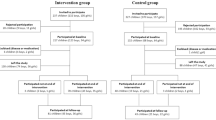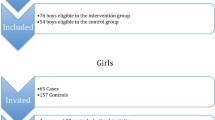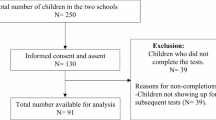Abstract
Purpose
Joint mobility is a fundamental part in physical activity program for children, but a scientific characterization of the methods to improve the articular mobility in healthy children is still poor. The aim of this study was to investigate whether joint mobility/muscular elasticity were related to a merely active lifestyle or could be significantly improved in the presence of a collective, easy-to-perform, but specifically designed and professionally guided program.
Methods
Specific functional and anthropometric parameters were single-blind tested on 277 children (aged 9–11 years). 148 were randomly assigned to a physical education program specifically designed to increase elasticity and supervised by professionals (treated group), while 129 (control group) continued their usual physical activity at school, with no specific program.
Results
Specific tests were performed and showed a significant improvement of joint mobility compared to non-specific physical activity in 9- to 11-year children. As a secondary end-point, this program was effective also in children of overweight/obese BMI category.
Conclusions
These results, building on those from this and other groups, should orientate decision-makers in the area of physical exercise for primary school children towards specifically designed programs based on demographic and anthropometric data.



Similar content being viewed by others
References
World Health Organization (WHO) (2010) Global recommendations on physical activity for health, Geneva
Hallal PC, Andersen LB, Bull FC, Guthold R, Haskell W, Ekelund U (2012) Global physical activity levels: surveillance progress, pitfalls, and prospects. Lancet 380:247–257
Soucie JM, Wang C, Forsyth A et al (2011) Hemophilia treatment center network. Range of motion measurements: reference values and a database for comparison studies. Haemophilia 17:500–507
Kwon JW, Lee WJ, Park SB, Kim MJ, Jang SH, Choi CK (2013) Generalized joint hypermobility in healthy female Koreans: prevalence and age-related differences. Ann Rehabil Med 37:832–838
Greene W, Heckman JD (1994) The clinical measurement of joint motion. American Academy of Orthopaedic Surgeons, Rosemont
Dantas EHM, Daoud R, Trott A, Nodari RJ Jr, Conceição M (2011) Flexibility: components, proprioceptive mechanisms and methods. Biomed Hum Kinet 3:39–43
Tyrrell VJ, Richards G, Hofman P, Gillies GF, Robinson E, Cutfield WS (2001) Foot-to-foot bioelectrical impedance analysis: a valuable tool for the measurement of body composition in children. Int J Obes Relat Metab Disord 25:273–278
Galli D, Volta E, Milioli MA et al (2012) Anthropometric outcomes associated with a primary school-based health promotion program in the Italian city of Parma. Sport Sci Health 7:41–46
Cole TJ, Bellizzi MC, Flegal KM, Dietz WH (2000) Establishing a standard definition for child overweight and obesity worldwide: international survey. BMJ 320:1240–1243
Kuczmarski RJ, Ogden CL, Guo SS et al (2002) 2000 CDC growth charts for the United States: Methods and development. Vital Health Stat 246:1–203
Chiodera P, Volta E, Gobbi G et al (2008) Specifically designed physical exercise programs improve children’s motor abilities. Scand J Med Sci Sports 18:179–187
Steindler A (1955) Kinesiology of the human body. Charles C. Thomas, Springfield
Uçar M, Koca I, Eroglu M et al (2014) Evaluation of open and closed kinetic chain exercises in rehabilitation following anterior cruciate ligament reconstruction. J Phys Ther Sci 26:1875–1878
Ismail MM, Gamaleldein MH, Hassa KA (2013) Closed kinetic chain exercises with or without additional hip strengthening exercises in management of patellofemoral pain syndrome: a randomized controlled trial. Eur J Phys Rehabil Med 49:687–698
Lee DR, Kim JS (2015) Improvement of internal and external rotation peak toque on little league baseball players with subacromial impingement syndrome by closed kinetic chain shoulder training. J Sport Rehabil (PubMed PMID 25932944)
Karandikar N, Vargas OO (2011) Kinetic chains: a review of the concept and its clinical applications. PM R 3:739–745
Carotenuto M, Gimigliano F, Fiordelisi G, Ruberto M, Esposito M (2013) Positional abnormalities during sleep in children affected by obstructive sleep apnea syndrome: the putative role of kinetic muscular chains. Med Hypotheses 81:306–308
Author information
Authors and Affiliations
Corresponding author
Ethics declarations
Conflict of interest
The authors declare that they have no conflict of interest.
Ethical approval
All procedures met the 1964 Helsinki declaration and its later amendments or comparable ethical standards. Data, reported in this manuscript, were anonymously generated. Subjects were exempt from possible physical, psychological and social injury. Therefore, in accordance with the Regulations of University of Parma and of the local Ethical Committee, no ethical permission was necessary for this study as it did not present the requirements for Ethical Committee evaluation.
Informed consent
Informed consent was obtained from the parents of all the participants included in the study.
Rights and permissions
About this article
Cite this article
Volta, E., Canali, V., Gobbi, G. et al. Joint mobility/muscular chain elasticity in a cohort of 9- to 11-year school children exposed to a specifically designed professionally guided training. Sport Sci Health 12, 347–352 (2016). https://doi.org/10.1007/s11332-016-0294-9
Received:
Accepted:
Published:
Issue Date:
DOI: https://doi.org/10.1007/s11332-016-0294-9




